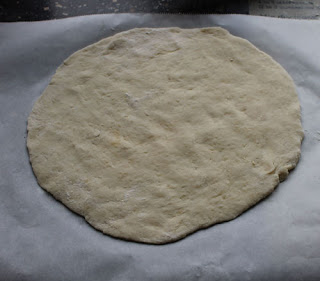It all started when I saw Molly Yeh make lefse with her
husband’s aunts on Girl Meets Farm. We
like that show because Molly lives in North Dakota on her husband’s farm. It
reminds Terry of home. The North Dakota setting also explains why Molly was
making lefse, a traditional Norwegian bread.
I know I’ve tried lefse before, but I can’t recall the
circumstances. At the time, I was unimpressed. Still, they are made with
potatoes, butter, flour, and salt—what’s not to like?
I found a recipe in The
King Arthur Flour Baker’s Companion. While indexed under “lefse,” the
recipe was actually titled, “Rich Potato Flatbread,” and described as an “Americanized
version.” I was going to make the lefse on Friday until I read that the dough
had to be refrigerated overnight. I mixed it on Friday and cooked it on
Saturday.
I began by peeling enough Russet potatoes to make two
pounds. It was more potatoes than I would have though, a priori. I used up all of the little runty Norkota potatoes that
were not suitable for baking. I used my potato ricer for potatoes for the first
time ever. I bought it to squeeze water out of grated zucchini before putting
it into a tart. Ricing potatoes is not hard, but is messier than just mashing
them in the pan, so I am not going to convert to making mashed potatoes with
the ricer.
I stirred in the butter, milk (which was supposed to be
cream, but I didn’t have any), and salt. When that was thoroughly blended, I
added flour and put it in the refrigerator.
King Arthur let me down the next day when I set to rolling
out the extremely sticky dough. There were no instructions on flouring or not
flouring. A novice would despair. I, on the other hand, started dusting all
surfaces in contact with the dough liberally with flour while I preheated a
cast iron skillet.
My first attempt was disastrous. It was firmly stuck to the
rolling mat. I tried with my largest spatula and longest palette knife to free
it, but it bunched and tore. I wadded it up into a ball again and started over.
 |
| Exceptionally sticky dough on rolling mat with palette knife |
By the third attempt, I gave up on the rolling pin. When I patted it out with
my hands, I could tell when it was starting to stick and add more flour
underneath. I also began transferring the flattened dough to a well-floured
piece of parchment paper for the final patting out. I shook the paper to be
sure the dough moved freely. If not, I snuck more flour underneath. The disk
then slid smoothly into the skillet.
 |
| Dough patted out on awell-floured parchment paper |
While one cooked (can you say baked if it’s in a skillet?),
I rolled out the next. Luckily, it did not seem to matter how hot the skillet
got. I kept the burner on the whole time, but none of the breads burned even
though I checked infrequently. The last few lefse puffed up in the middle,
which I took to be a positive sign that they were cooking through. I also
concluded that hotter was better.
 |
| Cooking in a cast iron skillet with flour everywhere |
The lefse was really good plain. I reheated them in a
skillet and served them for dinner with chicken noodle soup. It was even better
with butter and/or red raspberry jam.
When I first looked up the lefse recipe, I was delighted to
discover that it was in a chapter devoted to crackers and flatbreads. I have
always wanted to make good crackers and have tried various recipes over the
years without much success. I recipe for potato, dill, and onion crackers
caught my eye because it used leftover mashed potatoes, which had been languishing
in my refrigerator. Upon measuring, I found I had exactly the right amount for
a half batch.
The recipe suggested rolling the dough out on parchment
paper and then just transferring the crackers on the parchment to the baking
sheet. After baking for the requisite amount of time, I discovered that an
instruction was missing—separate the crackers after cutting them. The book said
they would get crispier as they cooled, but even at room temperature the
crackers in the middle of the pack were tough and flexible. I spread them out
and put them back in the oven. It helped some. Another problem was that some
were thicker than others. I loved the taste, though. Next time, I will put the
dough through the pasta maker.
 |
| Potato, dill, and onion crackers after the first (unsatisfactory) baking |
I had fun with my little experiments. Perhaps when I retire,
I can devote myself to making a perfect cracker. I’ll have to pace myself so I
don’t weigh ten thousand pounds by the end of the first year.
No comments:
Post a Comment